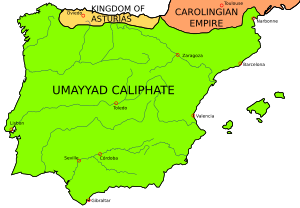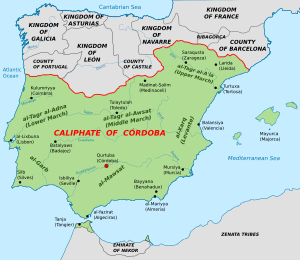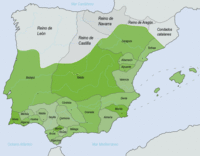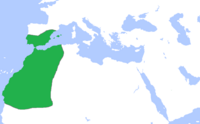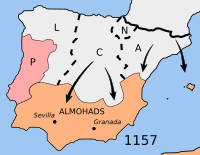Gharb al-Andalus facts for kids
Gharb al-Andalus was a special name given by Muslims to a part of the Iberian Peninsula. It means "west of al-Andalus" in Arabic. People also called it al-Gharb, meaning "the west."
This area included southern modern-day Portugal and parts of west-central Spain. Muslims ruled this land from 711 to 1249. This period began when the Visigothic kingdom fell. A leader named Tariq ibn-Ziyad invaded Iberia, and the Umayyad Empire took control. Today, the Algarve region in Portugal gets its name from this old Arabic word. About 500,000 people lived in this region during that time.
Contents
Umayyad Conquest of Iberia
Before the Muslim conquest, the Visigothic Kingdom in Hispania (what is now Spain and Portugal) had some internal problems. King Roderic was in charge, but some people didn't like him. His opponents, who were in Ceuta, asked a Muslim general named Musa ibn Nusair for help.
General Musa was careful at first. He sent a small group of soldiers, mostly from North and West Africa, led by Tariq ibn Ziyad. This was the start of the Muslim takeover of Iberia. Tariq's army completely defeated King Roderic's Visigothic army in the Battle of Guadalete. Soon after, they captured important cities like Toledo and Córdoba.
Because Tariq was so successful, General Musa joined the expedition. He became the governor of these new lands. By 714, cities like Évora, Santarém, and Coimbra were under Muslim control. Two years later, Lisbon was also captured. By 718, most of what is now Portugal was ruled by the Umayyads.
The Umayyads eventually stopped expanding into Europe. Their advance was halted in a famous battle between Poitiers and Tours. However, Muslim rule in Iberia lasted for a very long time, until 1492, when the Kingdom of Granada fell.
Emirate and Caliphate of Córdoba
After the initial conquest, the Muslim lands in Iberia became known as the Emirate of Córdoba. This Emirate lasted from 756 to 929. An Emirate is a territory ruled by an Emir, a type of Muslim leader.
Later, in 929, the Emirate became even more powerful and was called the Caliphate of Córdoba. A Caliph is seen as a successor to the Islamic prophet Muhammad. This Caliphate was a very important and advanced center of learning and culture in Europe. It lasted until 1031. After the Caliphate ended, the large Muslim territory broke up into many smaller kingdoms called Taifas.
First Taifa Period
- Further information: Taifa
When the Caliphate of Córdoba ended in 1031, the Muslim lands in Iberia split into many smaller, independent states. These were called Taifas. Each Taifa was ruled by its own leader.
In the region that is now Portugal, several Taifas appeared:
- The first Taifa of Badajoz was ruled by the Aftasid dynasty. It existed from 1009 to 1094.
- The Taifa of Lisbon was a smaller kingdom from 1022 to 1034. It then became part of the Taifa of Badajoz. For a short time, from 1093 to 1094, Alfonso VI of León and Castile, a Christian king, ruled Lisbon.
- The first Taifa of Mértola lasted from 1033 to 1044. It then joined the Taifa of Seville.
- The Taifa of Santa Maria do Algarve existed from 1018 to 1051. It also became part of the Taifa of Seville.
- The first Taifa of Silves was a kingdom from 1040 to 1063. It too was later taken over by the Taifa of Seville.
- The Taifa of Santarém was a very short-lived kingdom from 1144 to 1145. It then became part of the Taifa of Badajoz.
Almoravid Dynasty Rule
The Taifa kingdoms were often weak and fought among themselves. This made them easy targets for Christian kingdoms from the north. To fight back, some Taifa rulers asked for help from a powerful Muslim group from North Africa called the Almoravid dynasty.
The Almoravids ruled a large empire from 1040 to 1147. They came to Iberia and took control of many Taifa kingdoms, including parts of what is now southern Portugal. They helped unite the Muslim lands for a while.
However, the Christian kingdoms continued their efforts to retake land. In 1147, after a successful siege, the newly formed Kingdom of Portugal gained control of Lisbon. This was a very important victory for Portugal.
Second Taifa Period
After the Almoravid dynasty became weaker and lost control, the Muslim lands in Iberia once again broke up into smaller Taifa kingdoms. This was known as the second Taifa period.
In the area of modern-day Portugal, three new Taifas appeared:
- The second Taifa of Mértola existed from 1144 to 1151.
- The second Taifa of Silves also lasted from 1144 to 1151.
- The Taifa of Tavira was a kingdom from 1146 to 1150.
All three of these Taifas eventually became part of a new, powerful Muslim empire from North Africa called the Almohad Caliphate in 1151.
Almohad Caliphate Rule
The Almohad Caliphate was another strong Muslim empire that ruled from 1121 to 1269. For much of this time, until 1249, they controlled a large part of what is now southern Portugal. They tried to stop the Christian kingdoms from expanding.
However, the Christian kingdoms, including Portugal, continued their efforts to retake the land. This long process is known as the Reconquista. Eventually, in the late 1230s, a new small Taifa kingdom formed in Niebla. This kingdom controlled the region until 1249.
In that year, 1249, the Kingdom of Portugal finally conquered Faro. This victory marked the end of Muslim rule in the region of Gharb al-Andalus and completed the Portuguese Reconquista.
See also
 In Spanish: Garb al-Ándalus para niños
In Spanish: Garb al-Ándalus para niños
- Timeline of Portuguese history
- Timeline of the Muslim occupation of the Iberian Peninsula
- Reconquista
- Kingdom of Algarve
- Kingdom of Portugal
- Silves


